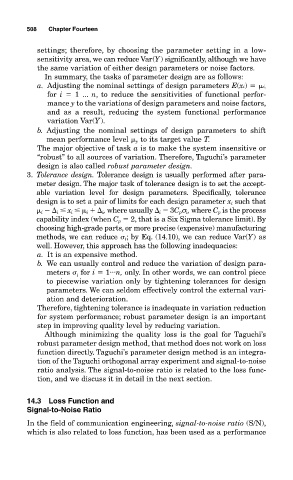Page 549 - Design for Six Sigma a Roadmap for Product Development
P. 549
508 Chapter Fourteen
settings; therefore, by choosing the parameter setting in a low-
sensitivity area, we can reduce Var(Y) significantly, although we have
the same variation of either design parameters or noise factors.
In summary, the tasks of parameter design are as follows:
a. Adjusting the nominal settings of design parameters E(xi) i,
for i 1 ... n, to reduce the sensitivities of functional perfor-
mance y to the variations of design parameters and noise factors,
and as a result, reducing the system functional performance
variation Var(Y).
b. Adjusting the nominal settings of design parameters to shift
mean performance level y to its target value T.
The major objective of task a is to make the system insensitive or
“robust” to all sources of variation. Therefore, Taguchi’s parameter
design is also called robust parameter design.
3. Tolerance design. Tolerance design is usually performed after para-
meter design. The major task of tolerance design is to set the accept-
able variation level for design parameters. Specifically, tolerance
design is to set a pair of limits for each design parameter x i such that
i i x i i i , where usually i 3C pσ i , where C p is the process
capability index (when C p 2, that is a Six Sigma tolerance limit). By
choosing high-grade parts, or more precise (expensive) manufacturing
methods, we can reduce i ; by Eq. (14.10), we can reduce Var(Y) as
well. However, this approach has the following inadequacies:
a. It is an expensive method.
b. We can usually control and reduce the variation of design para-
...
meters for i 1 n, only. In other words, we can control piece
i
to piecewise variation only by tightening tolerances for design
parameters. We can seldom effectively control the external vari-
ation and deterioration.
Therefore, tightening tolerance is inadequate in variation reduction
for system performance; robust parameter design is an important
step in improving quality level by reducing variation.
Although minimizing the quality loss is the goal for Taguchi’s
robust parameter design method, that method does not work on loss
function directly. Taguchi’s parameter design method is an integra-
tion of the Taguchi orthogonal array experiment and signal-to-noise
ratio analysis. The signal-to-noise ratio is related to the loss func-
tion, and we discuss it in detail in the next section.
14.3 Loss Function and
Signal-to-Noise Ratio
In the field of communication engineering, signal-to-noise ratio (S/N),
which is also related to loss function, has been used as a performance

